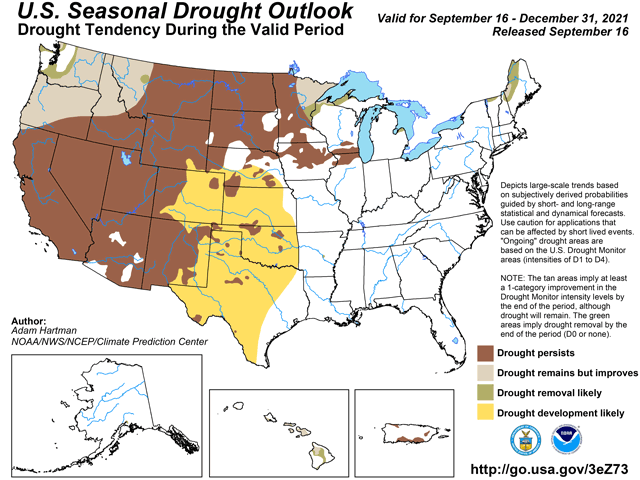Plains Drought Forecast Grows
Drought Expected to Continue and Spread in Central US
The latest seasonal forecasts point to drought not only hanging on but widening in the central U.S. through the balance of calendar year 2021 and playing a featured role in the start of the 2022 crop year. The forecasts call for drought to cover the entire Southern Plains over the next three months. In addition, drought that is in place in the Northern Plains has only limited easing. And areas of the western and northern Midwest which are dry are expected to remain that way.
Extreme to exceptional drought in the Northern Plains has been well documented this 2021 crop year. But in a recent forecast conference call, Drought Monitor Climatologist Brian Fuchs noted some big precipitation deficits in the central and north-central Midwest as well. From mid-August to mid-September, "We see deficits of up to three inches in Illinois, northern Missouri and southern Iowa, and calendar year deficits in central Iowa and northern Illinois of 12 to 15 inches," Fuchs said. For another example of harsh dryness, Fuchs pointed to Chicago, Illinois. Chicago recorded its driest calendar year through mid-September since 2005, including .02 inches less than the headline Midwest drought year of 2012.
Fuchs also observed that persistence of very warm to hot temperatures deep into September helped set the stage for drying out; record or near-record warm temperatures continued more than halfway through September. "This shortens the autumn season," Fuchs said, referring to available time for soils to take in moisture before freezing up in winter. "The evaporative demand for moisture is still quite high for this time of year," he said.
P[L1] D[0x0] M[300x250] OOP[F] ADUNIT[] T[]
Dryness in place, a warm start to the fall season and the development of La Nina combine for drought to either continue or develop in the Plains through the western and north-central Midwest during the balance of this year. In terms of crop area coverage, both classes of hard wheat -- hard red winter and hard red spring -- have drought forecast to either remain or develop in almost their entire acreage in the Plains. Drought easing (but still in effect) is expected only in north-central and northwestern Montana.
That drought outlook is echoed in the DTN seasonal forecast as well. "The DTN forecast is calling for below-normal precipitation through at least October as ridging (upper atmosphere high pressure) will likely dominate the country," said DTN Ag Meteorologist John Baranick. "The pattern looks a little more active for November and December, but that does not indicate any significant changes to the drought situation."
The expected impact of a developing La Nina in the Pacific Ocean is prominently featured in the forecast. The NOAA Pacific forecast calls for a 70% to 80% chance of La Nina to develop and be in effect during the upcoming 2021-22 winter season. "The official forecast depicts probabilities of La Nina that are significantly higher than climatological probabilities through the upcoming winter," noted the Climate Prediction Center forecast summary. La Nina is officially defined as the periodic cooling of ocean surface temperatures in the central and east-central equatorial Pacific. Typically, La Nina events occur every 3 to 5 years or so, but on occasion can occur over successive years.
As of Sept. 1, Pacific Ocean equatorial region temperatures ranged from 0 degrees Celsius to 0.5 deg C below average; the La Nina temperature threshold is 0.5 to 1.0 C below average. The Southern Oscillation Index (SOI) barometric pressure component of the Pacific Ocean situation showed values of plus 10.53 on the 30-day average and plus 9.64 on the 90-day average on Wednesday, Sept. 22. Both values are in the La Nina category.
Research conducted in the late 1980s shows a strong correlation between La Nina in the Pacific Ocean and drier conditions in the Southern Plains. That research also shows a tendency toward above-average precipitation in the northwestern U.S. Indeed, the very dry northwest crop areas have some drought easing in the forecast. However, drought is still expected to be in effect by the end of 2021.
Bryce Anderson can be reached at Bryce.anderson@dtn.com
Follow him on Twitter @BAndersonDTN
(c) Copyright 2021 DTN, LLC. All rights reserved.




